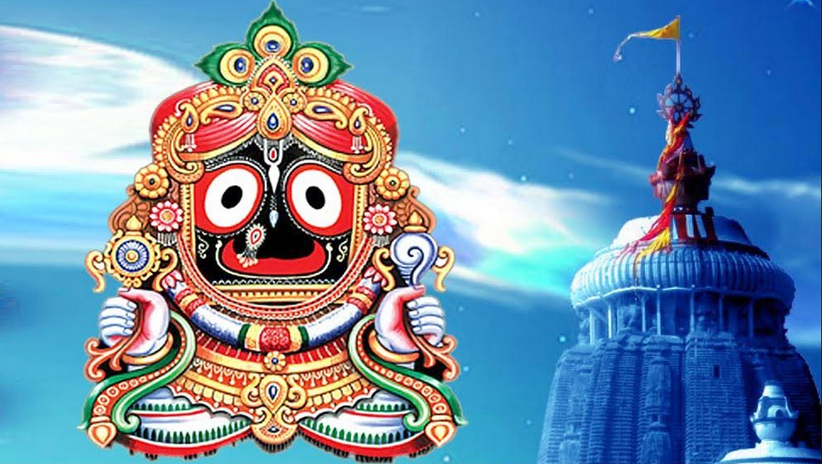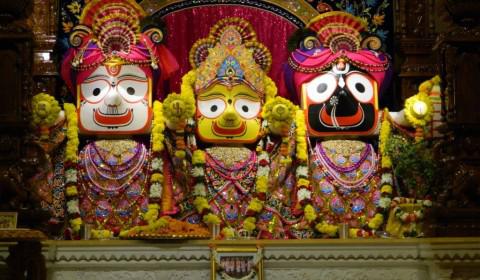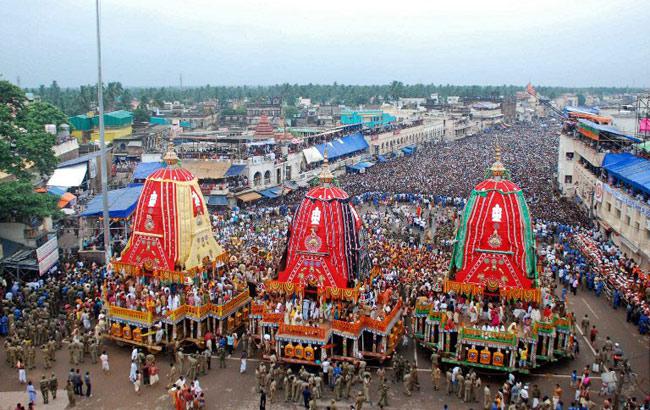Puri Jagannath Temple
Odisha
Name of the Temple : Puri Jagannath Temple
Main Deity : Jagannath, Baladev and Subhadra
Local Name : Jagannath, Balabhadra and Subhadra
Location : Puri, Orissa
Nearest City : Bhubaneswar
Website : http://www.jagannath.nic.in/
Importance of the temple : It is also called as Purushottama Kshetra. Nilachala dham is one of the char dhams. This Kshetra is very purifying. One who visits the Purushottama Kshetra reaps the benefits equal to travelling to all Holy Teerthas.
Jagannath Prarthana:
neelAchala-nivAsAya nityAya paramAtmane
balabhadra-subhadraAbhyAm jagannAthAya te namah
jagadA-nanda-kandAya praNatArta-harAya cha
neelAchala-nivAsAya jagannAthAya te namah
History:
Puri is in the state of Orissa and closer to Bhubaneshwar. Jagannath temple in Puri is one of the char dhams (Badrinath, Dwarka, Puri and Rameswaram).
Lord Vishnu resides here in the wood form of deity and is known as Daru Brahma. He is present in Purushottama Kshetra in His saakshat swarupa, His original form and hence named after himself (Purushottama). Anyone who takes His darshan here, is sure to attain liberation. Lord Jagannath Simhasana is called Ratna Simhasana. In the Puranas, Lord himself said that, "I will never leave this place even if my temple is broken. Even during the maha pralaya, I will be here".
Story goes as follows:
King Indradyumna was a great devotee of Lord Vishnu and wanted to see the Lord face to face. Once a brahmana told him that he can see the Lord face to face in Purushottama dhama and disappeared. The king sent out his people in search of that place and Vidyapati was one among them. Vidyapati met Viswavasu while searching for the Purushottama dhama and married his daughter Lalitha. Viswavasu used to secretly worship the Lord in a dense forest.
Vidyapati found Viswavasu's behaviour peculiar. He saw that every day Viswavasu goes somewhere and comes back in the night. A nice fragrance used to emanate from his body when he returned home. Out of curiosity, when Vidyapati enquired his wife she told him that her father goes to pray Nila Madhava every day. At the insistence of Vidyapati, Viswavasu took him to see Nila Madhava, blind folding him. Being intelligent, Vidyapati dropped mustard seeds on the way so that he could identify the place later. When he saw Nila Madhava he became ecstatic. He immediately informed his King, Indradyumna.
As soon as the King heard the news he travelled to see Nila Madhava, but, to his surprise, Nila Madhava had disappeared. King became very angry and arrested Viswavasu. The King then heard a celestial saying, "Release Viswavasu. On top of Nila hill you should construct a temple. There I will manifest as Daru-Brahman (the Absolute Truth manifested in a wooden form) on the shores of Puri. You will not see me as Nila Madhava."
King then started the construction of the temple. Brahma himself in the guise(form) of aged Viswakarma approached Indradyumna for the carpentry work. He wanted 21 days to complete the work. Brahma insisted that the doors were to be locked and that no one should enter the place. King was able to hear the sound of the carpentry for some days. After which he could not hear anything. Worried that something happened to the carpenter and on insistence of the Queen, he got the doors opened. Viswakarma immediately disappeared and they found unfinished idols of Lord Jagannath, Balabhadra and Subhadra. These are the deities we see now in the temple.
Name of the Temple : Puri Jagannath Temple
Main Deity : Jagannath, Baladev and Subhadra
Local Name : Jagannath, Balabhadra and Subhadra
Location : Puri, Orissa
Nearest City : Bhubaneswar
Website : http://www.jagannath.nic.in/
Importance of the temple : It is also called as Purushottama Kshetra. Nilachala dham is one of the char dhams. This Kshetra is very purifying. One who visits the Purushottama Kshetra reaps the benefits equal to travelling to all Holy Teerthas.
Jagannath Prarthana:
neelAchala-nivAsAya nityAya paramAtmane
balabhadra-subhadraAbhyAm jagannAthAya te namah
jagadA-nanda-kandAya praNatArta-harAya cha
neelAchala-nivAsAya jagannAthAya te namah
History:
Puri is in the state of Orissa and closer to Bhubaneshwar. Jagannath temple in Puri is one of the char dhams (Badrinath, Dwarka, Puri and Rameswaram).
Lord Vishnu resides here in the wood form of deity and is known as Daru Brahma. He is present in Purushottama Kshetra in His saakshat swarupa, His original form and hence named after himself (Purushottama). Anyone who takes His darshan here, is sure to attain liberation. Lord Jagannath Simhasana is called Ratna Simhasana. In the Puranas, Lord himself said that, "I will never leave this place even if my temple is broken. Even during the maha pralaya, I will be here".
Story goes as follows:
King Indradyumna was a great devotee of Lord Vishnu and wanted to see the Lord face to face. Once a brahmana told him that he can see the Lord face to face in Purushottama dhama and disappeared. The king sent out his people in search of that place and Vidyapati was one among them. Vidyapati met Viswavasu while searching for the Purushottama dhama and married his daughter Lalitha. Viswavasu used to secretly worship the Lord in a dense forest.
Vidyapati found Viswavasu's behaviour peculiar. He saw that every day Viswavasu goes somewhere and comes back in the night. A nice fragrance used to emanate from his body when he returned home. Out of curiosity, when Vidyapati enquired his wife she told him that her father goes to pray Nila Madhava every day. At the insistence of Vidyapati, Viswavasu took him to see Nila Madhava, blind folding him. Being intelligent, Vidyapati dropped mustard seeds on the way so that he could identify the place later. When he saw Nila Madhava he became ecstatic. He immediately informed his King, Indradyumna.
As soon as the King heard the news he travelled to see Nila Madhava, but, to his surprise, Nila Madhava had disappeared. King became very angry and arrested Viswavasu. The King then heard a celestial saying, "Release Viswavasu. On top of Nila hill you should construct a temple. There I will manifest as Daru-Brahman (the Absolute Truth manifested in a wooden form) on the shores of Puri. You will not see me as Nila Madhava."
King then started the construction of the temple. Brahma himself in the guise(form) of aged Viswakarma approached Indradyumna for the carpentry work. He wanted 21 days to complete the work. Brahma insisted that the doors were to be locked and that no one should enter the place. King was able to hear the sound of the carpentry for some days. After which he could not hear anything. Worried that something happened to the carpenter and on insistence of the Queen, he got the doors opened. Viswakarma immediately disappeared and they found unfinished idols of Lord Jagannath, Balabhadra and Subhadra. These are the deities we see now in the temple.
Maha prasad - It is said that whoever takes the maha prasad will be liberated. Maha Prasad will first be offered to Bimla Devi and then served to devotees. Bimla Devi is none other than Parvati Devi, Consort of Lord Shiva. The temple has a vast kitchen for preparing Maha prasad.
Nabakalebara - Every 8th or 12th or 19th year of the previous Nabakalebara, the Deities will get a new body. "Naba" means new and "kalebara" means body that means change of the physical form. The old images are buried ceremoniously and new images are installed. During this time no one is allowed to see the Deities nor the process.
Ratha Yatra is one of the main events. On the day of Ratha Yatra, Jagannath, Balabhadra and Subhadra come out on their chariots to give darshan to all living entities who cannot enter into the temple otherwise. As mentioned earlier, having darshan of the Deities means liberation. With this belief Millions of people come to Puri during Ratha Yatra, just to have the darshan of the Deities on their chariots.
Lord Jagannatha’s Chariot is called Nandighosa. The Chariot of Lord Balabhadra is Taladhwaja and The Chariot of Subhadra is Darpadalana. The three chariots of Balabhadra, Subhadra and Jagannatha are constructed every year with wood of specific trees like phassi, dhausa, etc. These are customarily brought from the ex-princely state of Dasapalla, by a specialist team of carpenters who have hereditary rights and privileges for the same. The logs are set afloat as rafts in the river Mahanadi and are collected near Puri and then transported by road.
During Rath Yatra, devotees can have darshan of the Lord in Gundicha temple. They also call it as Adapa mandapa. Having darshan of the Lord here, one frees from all diseases. While for the rest of the year, it is the Jagannath temple that gets all the attention, during the nine-day Rath Yatra festivities the spotlight falls on the Gundicha temple.
Nabakalebara - Every 8th or 12th or 19th year of the previous Nabakalebara, the Deities will get a new body. "Naba" means new and "kalebara" means body that means change of the physical form. The old images are buried ceremoniously and new images are installed. During this time no one is allowed to see the Deities nor the process.
Ratha Yatra is one of the main events. On the day of Ratha Yatra, Jagannath, Balabhadra and Subhadra come out on their chariots to give darshan to all living entities who cannot enter into the temple otherwise. As mentioned earlier, having darshan of the Deities means liberation. With this belief Millions of people come to Puri during Ratha Yatra, just to have the darshan of the Deities on their chariots.
Lord Jagannatha’s Chariot is called Nandighosa. The Chariot of Lord Balabhadra is Taladhwaja and The Chariot of Subhadra is Darpadalana. The three chariots of Balabhadra, Subhadra and Jagannatha are constructed every year with wood of specific trees like phassi, dhausa, etc. These are customarily brought from the ex-princely state of Dasapalla, by a specialist team of carpenters who have hereditary rights and privileges for the same. The logs are set afloat as rafts in the river Mahanadi and are collected near Puri and then transported by road.
During Rath Yatra, devotees can have darshan of the Lord in Gundicha temple. They also call it as Adapa mandapa. Having darshan of the Lord here, one frees from all diseases. While for the rest of the year, it is the Jagannath temple that gets all the attention, during the nine-day Rath Yatra festivities the spotlight falls on the Gundicha temple.
Few incredible facts about Puri Jagannath temple:
HARE KRISHNA
- The flag located at the top of temple has been observed to flap in the opposite direction of the breeze.
- Irrespective of where you stand in Puri, it seems to you that the Sudarshana Chakra on top of the temple is always facing you.
- Usually in coastal areas during the day-time, the breeze blows from the sea towards the land and during evening hours it blows from the land towards the sea. But in the case of Puri it is the reverse.
- No birds/nothing fly above the Jagannath temple in Puri.
- The shadow of the main dome of Jagannath temple is not visible, whatever be the time of day. Maybe an architectural feat or the Lord’s desire.
- Usually the count of devotees visiting the temple varies from few thousands to lakhs depending on the day but the quantity of Prasadam cooked in the temple remains exactly the same throughout the year on any given day yet none of it goes insufficient or wasted.
- The prasadam is cooked in pots using firewood. Exactly 7 pots are put one on top of another. Surprisingly, the top most pot is cooked first followed by the bottom pots in order.
- After entering the temple from Singha dwara’s entrance, after the first step you cannot hear any sound produced by the ocean. But, when you exit it can be clearly heard. This can be noticed clearly during evening. There is no scientific explanation for this. Legend has it that Subhadra Mayi, the sister of the two Lords wished peace and serenity within the temple abode and hence it was made to come about that way.
- The Annual Ratha Yatra at Puri is performed with two sets of chariots (3 plus 3). As there is a river flowing in between Shrimandira and Gundicha (Mausi maa) temple, the first set of chariots were used to transport the Deities till the river, and then the Deities had to cross the river in three wooden boats and then board the other set of chariots to travel till the Gundicha (Mausi maa) temple.
HARE KRISHNA




